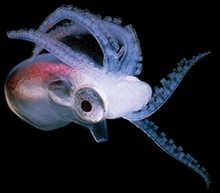 My illustrious colleagues have been re-examining some of the lab’s old data regarding the repression of competence by purines. The work has been slowly ongoing for years, and it may be close to being a complete story. I want to try and express what I think their model is and what seem to be its predictions, so they can tell me whether my understanding is straight…
My illustrious colleagues have been re-examining some of the lab’s old data regarding the repression of competence by purines. The work has been slowly ongoing for years, and it may be close to being a complete story. I want to try and express what I think their model is and what seem to be its predictions, so they can tell me whether my understanding is straight…First, a schematic depiction of how I interpret what we already know the induction of the competence regulon:
 What we knew: Transferring cells growing in rich medium to competence medium induces 15 operons driven from the novel CRP-S promoter, and then cells become naturally transformable. Cells in competence medium have elevated cyclic AMP levels, directing the CRP protein to induce expression of genes with canonical CRP-N promoters, including the sxy gene. Sxy protein alters the binding specificity of CRP to also bind at CRP-S promoters, thereby inducing competence gene expression.
What we knew: Transferring cells growing in rich medium to competence medium induces 15 operons driven from the novel CRP-S promoter, and then cells become naturally transformable. Cells in competence medium have elevated cyclic AMP levels, directing the CRP protein to induce expression of genes with canonical CRP-N promoters, including the sxy gene. Sxy protein alters the binding specificity of CRP to also bind at CRP-S promoters, thereby inducing competence gene expression.But Sxy levels are also regulated at translation, in addition to at transcription. The wild-type sxy mRNA transcript contains a stem-loop structure that inhibits its translation. Mutations that disrupt the stem-loop structure in the 5’-UTR are hypercompetent (e.g. the sxy-1 mutation). In wild-type cells, unknown factor(s) disrupt the stem-loop to induce the translation of sxy transcript in competence medium.
Now a schematic depiction of how I interpret the model for purine repression of competence:
 The observation: Addition of purines to competence medium represses competence. Purine biosynthesis is repressed by the PurR protein when cellular pools of purines are high. Deletion of the purR gene reduces competence (presumably indirectly, by increasing cellular pools of purine), but mutations disrupting the sxy 5’UTR’s stem-loop suppress the purR mutant defect (Rosie’s last post).
The observation: Addition of purines to competence medium represses competence. Purine biosynthesis is repressed by the PurR protein when cellular pools of purines are high. Deletion of the purR gene reduces competence (presumably indirectly, by increasing cellular pools of purine), but mutations disrupting the sxy 5’UTR’s stem-loop suppress the purR mutant defect (Rosie’s last post).A hypothesis: The sxy transcript stem-loop is stabilized in the presence of purines (either directly or indirectly), blocking the production of Sxy protein and thus the activation of the competence regulon. When purine pools are depleted, the stem-loop is disrupted. This predicts that addition of purines and purR mutations will inhibit sxy translation more than sxy transcription.
A corollary hypothesis: Purines block DNA translocation by PurR-dependent repression of the rec-2 gene, whose promoter contains a putative PurR binding site. A potential test of this hypothesis would be to treat sxy-1 competent cultures with purines. We would predict that if PurR directly represses rec-2, DNA translocation would be inhibited (but DNA uptake would not). Obviously, checking rec-2 transcription relative to other competence genes would make sense here as well, but the functional test would be most compelling.
Is that the basic notion? I know there’s a bunch of other experiments that have been done that I need to find out about…

No comments:
Post a Comment